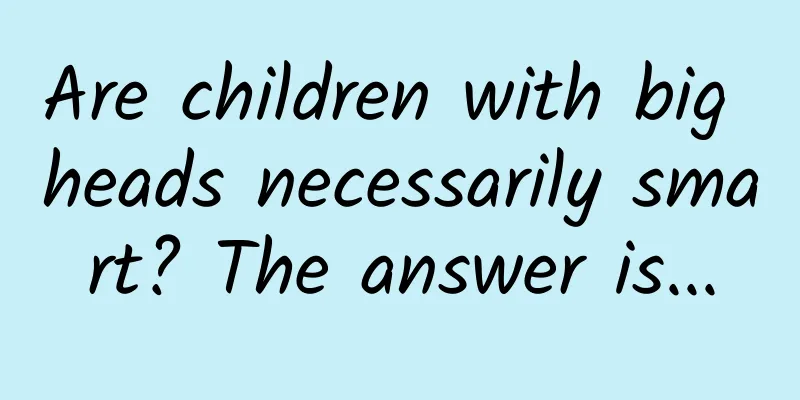Are children with big heads necessarily smart? The answer is...

|
Rumor: **** “Children with big heads are smart ” Many elderly people would praise children by saying, "This child has a big head, he will definitely be smart in the future." People tend to believe that the bigger a part of the body is, the more powerful its function is. As for the brain, a big head is intuitively believed to mean a large brain, which in turn leads to more brain cells and more intelligence. Rumor analysis: Not true. The scientific equivalent of a big head is actually a large brain. Differences in brain capacity can indeed explain differences in intelligence between people to a certain extent. However, this association is not inevitable. When the elderly praise children, they often say: This child has a big head, he will definitely be smart in the future. In traditional culture, a big head also represents intelligence, blessing and honesty. Perhaps it is because people tend to think that the bigger a part of the body is, the more powerful its function is. In the case of the brain, a big head is intuitively thought to mean a large brain, which in turn leads to more brain cells and greater intelligence. Brain capacity is not the bigger the better A big head and a correspondingly large brain volume can be described using a more scientific term - large brain capacity . Copyrighted stock images, reprinting may cause copyright disputes Differences in brain volume can indeed explain differences in intelligence between people to a certain extent. This is because a larger brain may have more neurons, which may form a more complex structure, thus affecting intelligence. However, this association is not inevitable. When we apply this speculation to the entire natural world, we find that it is not entirely true. For example, the sperm whale's brain is five times that of a human brain, but their intelligence is not much higher than that of a human. The cow's brain is more than 200 times heavier than that of a mouse, and is about the same size as a chimpanzee's brain. But obviously, cows are not only far less intelligent than chimpanzees, but are not even smarter than tiny mice. A large brain capacity does not necessarily mean high intelligence. Larger animals usually have larger brains, but these extra neurons are not entirely used to improve intelligence, but are used to control their larger bodies. A sufficient number of neurons is a necessary condition for high intelligence, but conversely, a sufficient number of neurons does not necessarily lead to high intelligence. In order to clarify the relationship between human brain volume and intelligence, scientists have used technologies such as CT and magnetic resonance imaging (MRI) to verify the relationship between human brain volume and intelligence many times, and finally concluded that the relationship between brain volume and intelligence is only moderately correlated, with a correlation coefficient of about 0.30~0.40. That is to say, brain volume does affect intelligence, but this effect is not as high as we think. In contrast, the influence of brain structure on human intelligence is actually higher. Thinking faster , all thanks to short routes In particular, brain connectivity is important for high intelligence. Intelligence cannot be generated by neurons alone. It should be known that when human babies are born, the neurons in their brains are already formed, but they do not have obvious intelligence. Intelligence can only gradually develop as they experience and build pathways between neurons in different intervals during their growth. It is the process of signal transmission and exchange along the pathways between these neurons that forms the so-called "thinking". Therefore, the smoother and faster the signal transmission path between different areas of the brain, the faster the brain processes information, and the higher the intelligence is likely to be. In addition, the shorter the signal transmission path, the higher the intelligence. The human brain is divided into multiple functional areas, and the thinking process often requires the cooperation of multiple areas. Scientists have found that the signal transmission path between different areas in the brain of smart people is more efficient and simple, so the signal transmission efficiency is also higher. There is a reason why smart people think fast. So does it mean that the more neural connections there are in the brain, the smarter a person is? We can use human cities as a simple analogy. Chongqing's traffic complexity is recognized nationwide. In such a city where overpasses are so complex that navigation is a problem, ordinary drivers, except for super experienced drivers, will get lost from time to time, and traffic efficiency has obviously not improved. The same is true for the brain. Too many and too messy pathways will reduce the efficiency of our signal transmission. In fact, the human brain also does subtraction during development. For example, as babies grow and are exposed to more environments and learn more, the number of signal pathways of their synaptic connections increases. But not all synaptic connections are beneficial. During development, synapses are constantly pruned to improve our thinking efficiency. The brain also needs to do subtraction to ensure high efficiency. The size of the head during childhood does need attention Although a big head does not mean high intelligence, the size of the head in infancy and childhood is indeed worthy of our attention. After a baby is born, head circumference is a very important growth indicator. If the head circumference grows too slowly, it may be due to brain underdevelopment or microcephaly, while too small a brain capacity will limit the formation of a child's intelligence. Looking in the mirror of rumors There are many rumors like this among the people, and many rumors about diseases are similar, such as "joint crackling means arthritis" and so on. The structure of each organ in our body is very complex, and we cannot simply attribute a phenomenon to one reason. When we encounter similar rumors, we should ask more professionals and check the information, so that we can break them one by one. Planning and production Author: Hydra popular science author Review | Zhan Lixuan, Professor of Neurology, The Second Affiliated Hospital of Guangzhou Medical University Zhao Wei, Chief Physician, Department of Neurology, Tianjin Teda Hospital |
<<: After grains and vegetables, can we also “ask for food from the forest”?
Recommend
Mobile QQ launches a fun feature: can display the other party's real-time battery level
As the most classic chat software in China, QQ is...
Testin enters crowd testing, launching the world's first professional mobile app crowd testing platform
Testin, a third-party mobile application and game...
"Old people use 9 keys, young people use 26 keys"? Your typing habits have betrayed you...
Just like the never-ending "sweet and salty&...
App promotion: preparation before listing on app stores and other promotion channels!
After the App is developed, promoting the App nat...
NVIDIA's new graphics card GTX 900 series has become an "antique" and has been abandoned
Although there is no factual evidence to support ...
Hisense Yu Zhitao: OTT large-screen marketing should achieve win-win results for all parties
On September 22, at the "2017 China OTT Larg...
9 things you need to know before stocking up on cherries for the Spring Festival!
As the Spring Festival approaches, everyone start...
This crab can open coconuts with its bare hands and even climb trees to eat birds!
In the hot summer, it is best to go to the beach ...
How to make use of private domain traffic for brand promotion and marketing?
Through this article, you will be popularized wit...
New efficacy of artemisinin, promising for treating this common disease
In 2015, Tu Youyou's team won the Nobel Prize...
iOS 17 update, major features return!
Early this morning, Apple pushed the iOS 17 beta ...
Cook cried after seeing Surface Pro 4 beat iPad Pro
According to data provided by market research fir...
How to operate new media well? New media operation positioning skills!
Before operating new media , we must first have a...
Nezha Conquers the Dragon King teaches you how to prevent cancer: fighting the cancer demon with three heads and six arms, you must prepare these "magic weapons"!
When the Dragon King stirred up the storm, Nezha ...









